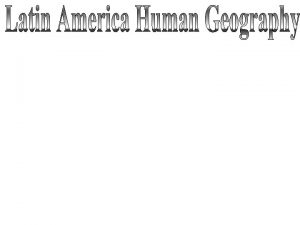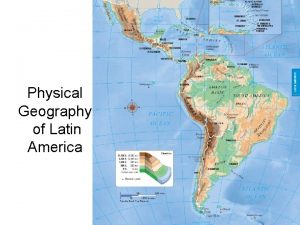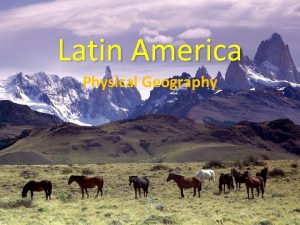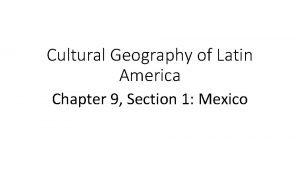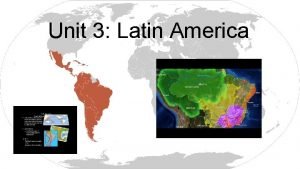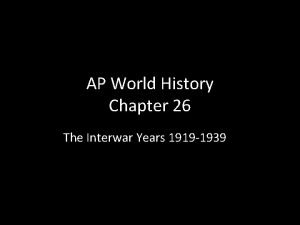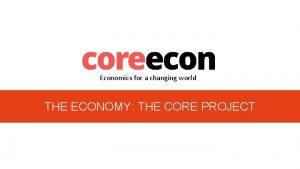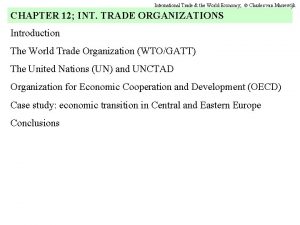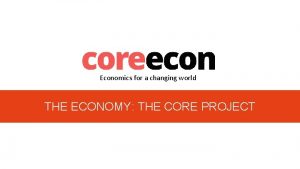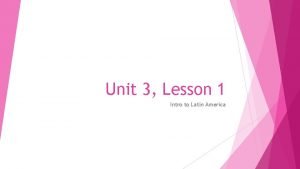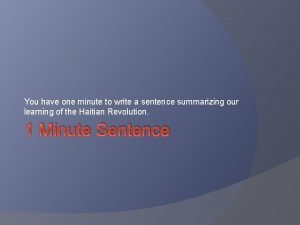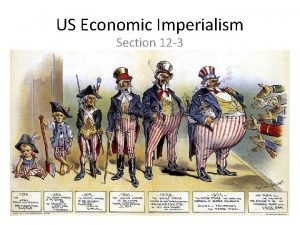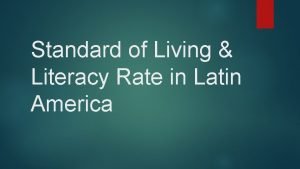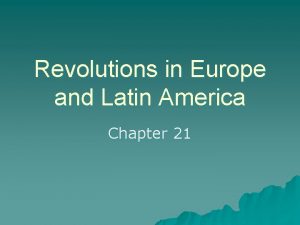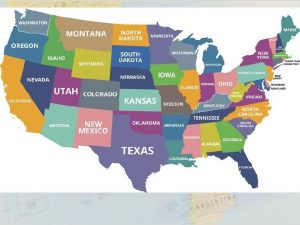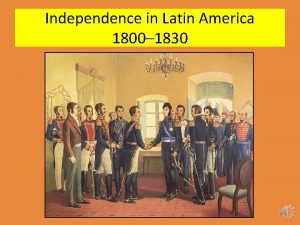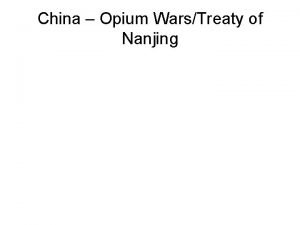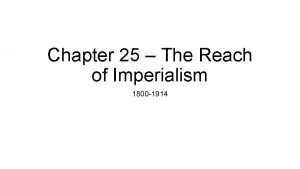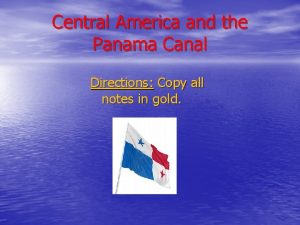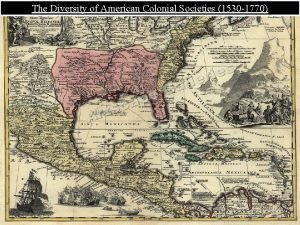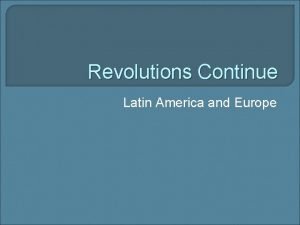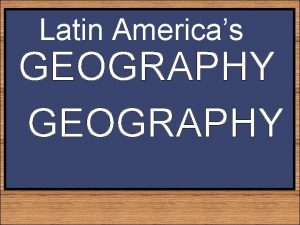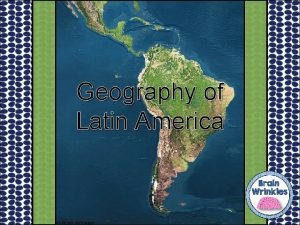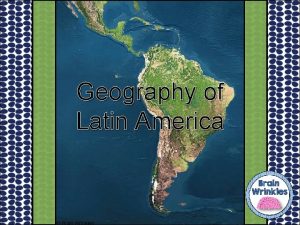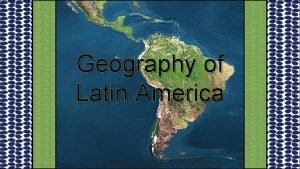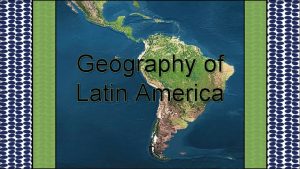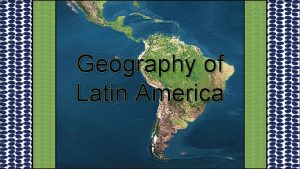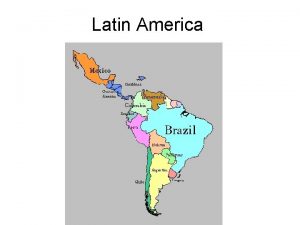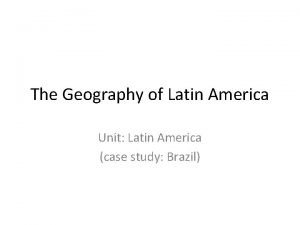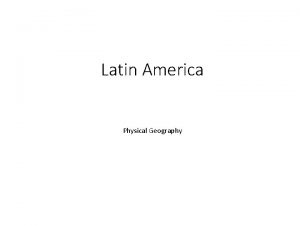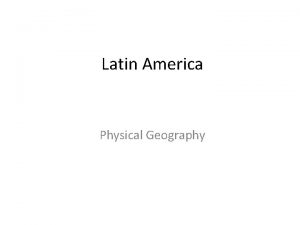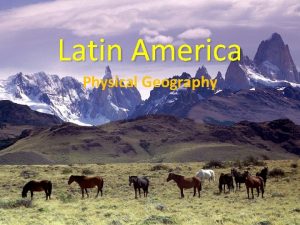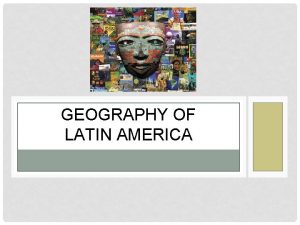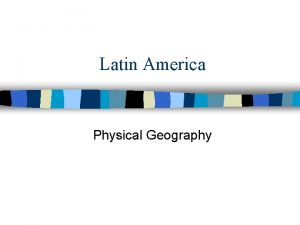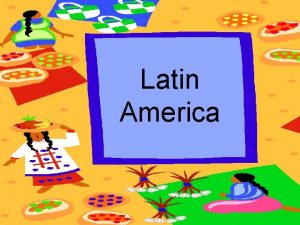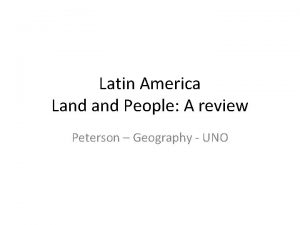Latin America in the World Economy Peterson Geography




































- Slides: 36

Latin America in the World Economy Peterson – Geography - UNO

Outline • Colonial Mercantile System • Independence, Neocolonialism, Export Economics • Economic retrenchment in the 20 th century • Regional integration 1960 – 1980 • Economic shock and realignment 1980 – 2000 • Regional integration 1990 and beyond • Global markets and global lives

Colonial Economy • Privatization of land – Forced labor or labor tribute • Extraction of resources – gold and silver – Sent back to Spain and Portugal • Haciendas and plantations – Production of export crop (coffee, sugar, bananas) • Imperative of European settlers was to make large sums of money – Why else live in the new World unless you are rich?

Spanish Imperialism • Imperialism: a policy of extending the rule or authority of an empire or nation over foreign countries, or of acquiring and holding colonies and dependencies. • Also acquisition of personal wealth. Spanish conquistador: “We came here to serve God and the king, and also to get rich. ” • Spain and Portugal, like other European countries, believed that the purpose of having foreign empires was to enrich the parent country. – This belief was based on the principles of mercantilism.

Mercantilism-1 • Definition: A political and economic policy, evolving with the modern national state. • Seeks to secure a nation's political and economic supremacy in its rivalry with other states. • Purpose is to accumulate wealth in the form of precious metals – by exporting the largest possible quantity of its products – importing as little as possible, thus establishing a favorable balance of trade.

Mercantilism-2 • A country’s economic strength depends on increasing the supply of gold by exporting more goods than are imported. • Under mercantilism, foreign lands had two roles: 1. supply the parent country with raw materials (lumber, cotton, sugar, and precious metals) 2. serve as a market to sell parent country’s manufactured goods (furniture, clothing, and tools) • Established terms of trade that favored the mother country at the expense of the colony

Mercantilism-3 • Inherent belief that the world only contained a fixed amount of wealth – to increase a country’s wealth, one country had to take some wealth from another • In order to maintain a favorable balance of trade, the goods exported must be of greater value than those imported. – Import raw materials / export finished goods • The development of colonies and trading posts played an important role in mercantilism – they were both sources of raw materials and markets for finished goods.


Control of Trade • Trade strictly controlled and only allowed with Spain • Limited number of ports that engaged in trade • In Spain, everything went through Cadiz • In the New World, Vera Cruz, Cartagena, Portobelo (present-day Panama), and Havanna • Trade with Buenos Aires went through Lima, Peru – very onerous

Pirates and Privateers • Slow, unarmed merchant ships carrying gold and silver were an easy target • Privateers: a private warship authorized by a country's government to attack foreign shipping – part of naval warfare from the 16 th to the 19 th century – proceeds distributed among the privateer's owners, officers and crew • Spanish implemented convoy system as early as mid-1500 s, continued until 1700 s • One round-trip to Spain and back each year

Independence • In the vacuum, Great Britain assumed the role as the new Imperialist power • Had learned from colonial failures, including that in North America, to rule indirectly – Limit military involvement – Supply loans to foreign governments – Invest in key export activities – Construction of transportation and communications infrastructure

British Indirect Rule • Neocolonialism • Behind-the-scenes political control • Threat of military force rather than its actual use – British military rarely used in Latin America • a cost-effective means of imposing British hegemony • In many Latin American nations, US assumes British position by the 1920 s

1800 s • Latin America still pursuing export of specific commodities – sugar, coffee, tin, nitrates • Formation of “Banana Republics” - term now used to describe any small nation that is controlled by outside interests • Reliance on coffee by many nations: 85% of exports for Guatemala; 79% El Salvador; 65% Nicaragua; 62% Brazil; 52% Venezuela • Economies controlled by boom-bust economic cycles

Boom and bust Rubber Trade • Natural rubber extracted from sap of tree native to Brazil • Amazon region experiences a tremendous economic boom • Tree is smuggled to Britain, successfully cultivated • British establish vast rubber plantations in Southeast Asia • Supply increases and price drops. Brazilian rubber barons go bust.

Boom and bust • • Cocoa (central America and Brazil) Mining – depletion of resources Guano (Peru) – bird dung high in nitrates Nitrate mining (Chile) – bust through development of synthetic chemical fertilizer

Railroad Development Railroads designed to get goods to ports. Peru

1800 s Export Boom in review • Commodity Export Strategy was mostly a failure in developing overall economy • Elites benefitted, as did some regions • Most economies showed negligible economic growth – Living standards actually declined during the century • Strategy did little to encourage local manufacturing and industry

Retrenchment in the 1900 s • Wars and depression influenced markets • Demand for non-essential items (coffee, cocoa) declined • Wars increased demand for tin, copper, lead, grains, meat – benefitting some nations • Demand declined in all areas during the depression of the 1930 s • Wars and depression cut-off supply of industrial goods

Move toward Industry, finally • 1914 -1980: Period of “inward orientation” • National economic protectionism • “Import substitution industrialization” – Substituting locally manufactured goods for imported products – Use of high tariffs to keep out foreign goods • By 1950 s, manufacture of consumer goods blossomed – radios, televisions, refrigerators • Cars – Brazil, Mexico, Argentina – Smaller countries tried, with government subsidies, to manufacture cars - Ecuador’s Andino

Government-sponsored industrialization • Individuals did not have capital or were unwilling to invest for fear of nationalization • Governments created state-owned industries, state-owned industrial complexes – Brazil’s Redondo steel – Brazil succeeds, other countries fail – EMBRAER aircraft, military weapons, steels exports • Import substitution strategy worked in the larger countries

1960 -1980 • Declining value of exports – 1946: Region accounted for 25% of world exports – 1975: only 8% • Continued inward development • Failed attempts at regional economic integration • Continued borrowing

1980 -2000 • Economic shock brought on by – borrowing, bad investments, reliance on a few export commodities foreign-exchange earnings, financial mismanagement • Inflation • Over 1000% a year in Argentina, Bolivia, Peru • Default on international loans, renegotiation – Lending organization (IMF) impose broad economic reform policies – Privatizing state companies

Chile’s success under Pinochet • Concentrating on export market • Increasing agricultural output, especially in export fruit market • 1990’s Chile growing at 7 percent a year, still around 5 percent • Result of neoliberal policies – Increasing income for some, declining income for most -- greater social inequality

Argentina’s Failures • Pursued neoliberal policies through 1990 s • 20% unemployment throughout the decade • 2002 economic collapse, unemployment up to 50% • Decline in value of currency

Regional Summary • Incomes increase for top 20% of population • No policies to increase wealth for bottom 80% – Progressive income taxation as a method of income re-distribution • 45% of Latin Americans live in poverty – 65% of rural population • Exception: Chile – Poverty reduced from 40% to 20% since 1980 s

MERCOSUR • MERCOSUR – 1991: Argentina, Brazil, Paraguay, and Uruguay – Associate members: Chile, Bolivia – Common system of tariffs, customs union – 2003: Free trade agreement with Andean community – Pushing accord with European Union

NAFTA 1992 • Phased implementation for Canada, US, Mexico • Tremendous increase in trade • Manufacturing job losses in US and Canada; increase in Mexico • 1. 3 million vehicles produced in Mexico; 1 million go to US and Canada

Maquiladoras • Established prior to NAFTA – Eliminated duties on imports if used in manufacture of products for export – Tremendous growth through 2000 – Increased wages in the border region • After 2000, duty free area extended into Mesa Central – Maquiladoras began to decline

NAFTA and FTAA • NAFTA as first step • Free Trade Area of the Americas – Much broader free trade area – Combat MERCOSUR • 2004: US and Chile free trade pact • 2005: Central American Free Trade Agreement – CAFTA with Guatemala, Nicaragua, El Salvador, Costa Rica






Global Lives • Immigrants as transnational • With telecommunications and Internet – Live between two worlds – Homeland the new world – Changing both communities

Remittances • Sending money back home • 60% of Latin American immigrants send money back home; mostly new immigrants – Most send money monthly – 20% of Mexicans receive remittances • 2004: Immigrants sending $30 billion home • Total foreign aid from developed to developing world is only $52 billion
 Why called latin america
Why called latin america Trigrams for replican of peterson and peterson
Trigrams for replican of peterson and peterson Largest economy in latin america
Largest economy in latin america Physical features of south america
Physical features of south america Environmental issues cloze notes 1 answer key
Environmental issues cloze notes 1 answer key Rio grande river
Rio grande river Cultural geography of latin america
Cultural geography of latin america Latin america's geography cloze notes 1
Latin america's geography cloze notes 1 Chapter 8: the physical geography of latin america answers
Chapter 8: the physical geography of latin america answers Amazon river
Amazon river We can do a rap of the map of the us
We can do a rap of the map of the us Athens vs sparta differences
Athens vs sparta differences How did geography affect egypt's economy
How did geography affect egypt's economy Countries between south america and africa
Countries between south america and africa Repetition in let america be america again
Repetition in let america be america again Performance e body art
Performance e body art Fascist corporatist economy ap world
Fascist corporatist economy ap world The economy: economics for a changing world
The economy: economics for a changing world World-economy
World-economy Answert the public
Answert the public Plateau facts
Plateau facts Latin america webquest answers
Latin america webquest answers Lesson 1 physical geography of south america
Lesson 1 physical geography of south america Peninsularies
Peninsularies South american map
South american map Literacy rates in south america
Literacy rates in south america Revolutions in europe and latin america section 2 quiz
Revolutions in europe and latin america section 2 quiz Middle america
Middle america Latin american city models
Latin american city models Latin america hierarchy
Latin america hierarchy Latin america physical features map
Latin america physical features map Latin america hierarchy
Latin america hierarchy Where is latin
Where is latin The reach of imperialism vocabulary activity
The reach of imperialism vocabulary activity Ecotourism acrostic
Ecotourism acrostic Caste system in latin america
Caste system in latin america Peninsulares creoles mestizos
Peninsulares creoles mestizos


